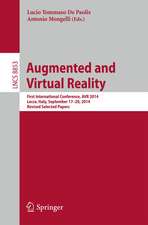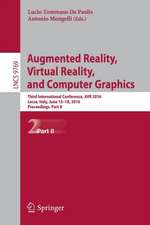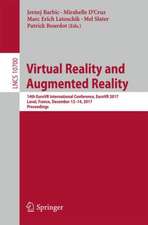Human Factors of Stereoscopic 3D Displays
Autor Robert Earl Patterson, Ph.D.en Limba Engleză Hardback – 19 mar 2015
The reader will learn how to design stereo displays from a human vision/human factors perspective.
Over the past several years, there has been a growing interest in the development of high-quality displays that present binocular parallax information to the human visual system for inducing the perception of three-dimensional depth. The methods for presenting binocular parallax to an observer vary widely and include three broad categories of display: stereoscopic, holographic and volumetric displays. Because the technology for stereoscopic displays is more developed and more widely used, than those based on holography or volumetric methods, the proposed book addresses those human factors issues involved in the viewing of stereoscopic displays.
Despite the diverse methods for creating stereoscopic displays, which includes stereo spatial multiplexing as well as temporal multiplexing (i.e., field sequential) techniques, there remain common human factor issues that arise when viewing such displays. Human Factors of Stereoscopic Displays will provide a detailed review of these important issues so that they can be considered when designing and using 3D displays. In doing so, the following topics will be covered: interocular cross talk; interocular differences in luminance and contrast; accommodation-vergence mismatch; stereoanomaly; spatio-temporal frequency effects; distance scaling of disparity and high-level cue conflict.
body>
| Toate formatele și edițiile | Preț | Express |
|---|---|---|
| Paperback (1) | 297.47 lei 38-44 zile | |
| SPRINGER LONDON – 5 oct 2016 | 297.47 lei 38-44 zile | |
| Hardback (1) | 329.58 lei 6-8 săpt. | |
| SPRINGER LONDON – 19 mar 2015 | 329.58 lei 6-8 săpt. |
Preț: 329.58 lei
Preț vechi: 411.98 lei
-20% Nou
Puncte Express: 494
Preț estimativ în valută:
63.07€ • 65.61$ • 52.07£
63.07€ • 65.61$ • 52.07£
Carte tipărită la comandă
Livrare economică 14-28 aprilie
Preluare comenzi: 021 569.72.76
Specificații
ISBN-13: 9781447166504
ISBN-10: 1447166507
Pagini: 80
Ilustrații: X, 104 p. 32 illus., 7 illus. in color.
Dimensiuni: 155 x 235 x 12 mm
Greutate: 0.34 kg
Ediția:2015
Editura: SPRINGER LONDON
Colecția Springer
Locul publicării:London, United Kingdom
ISBN-10: 1447166507
Pagini: 80
Ilustrații: X, 104 p. 32 illus., 7 illus. in color.
Dimensiuni: 155 x 235 x 12 mm
Greutate: 0.34 kg
Ediția:2015
Editura: SPRINGER LONDON
Colecția Springer
Locul publicării:London, United Kingdom
Public țintă
ResearchCuprins
1. Introduction to Human Factors of Stereoscopic Displays.- Part I: Background Information.- 2. Basics of Human Binocular Vision.- 3. Stimulus Arrangements for Creating Stereoscopic Displays.- Part II: Factors That Affect Stereo Depth Perception in Stereo Displays.- 4. Low-Level Factors.- 5. Low-Level Factors Continued.- 6. Contextual Factors.- 7. Contextual Factors Continued.- 8. High-Level Factors.- 9. High-Level Factors Continued.- Part III: Recommendations for Stereoscopic Display Design.- 10. Recommendations for Stereoscopic Display Design.
Textul de pe ultima copertă
This book provides an overview of all vision-relevant topics and issues that inform stereo display design from a user-centric, or human factor, perspective. Although both the basic vision science literature and the applied literature will be reviewed, the strength and originality of this book comes from the emphasis on the basic science literature on human stereo vision and its implications for stereo display design.
The reader will learn how to design stereo displays from a human vision / human factors perspective.
Over the past several years, there has been a growing interest in the development of high-quality displays that present binocular parallax information to the human visual system for inducing the perception of three-dimensional depth. The methods for presenting binocular parallax to an observer vary widely and include three broad categories of display: stereoscopic, holographic, and volumetric displays. Because the technology for stereoscopic displays is more developed, and more widely used, than those based on holography or volumetric methods, the proposed book addresses those human factors issues involved in the viewing of stereoscopic displays.
Despite the diverse methods for creating stereoscopic displays, which includes stereo spatial multiplexing as well as temporal multiplexing (i.e., field sequential) techniques, there remain common human factor issues that arise when viewing such displays. Human Factors of Stereoscopic 3D Displays will provide a detailed review of these important issues so that they can be considered when designing and using 3D displays. In doing so, the following topics will be covered: interocular cross talk; interocular differences in luminance and contrast; accommodation-vergence mismatch; stereoanomaly; spatio-temporal frequency effects; distance scaling of disparity; and high-level cue conflict.
The reader will learn how to design stereo displays from a human vision / human factors perspective.
Over the past several years, there has been a growing interest in the development of high-quality displays that present binocular parallax information to the human visual system for inducing the perception of three-dimensional depth. The methods for presenting binocular parallax to an observer vary widely and include three broad categories of display: stereoscopic, holographic, and volumetric displays. Because the technology for stereoscopic displays is more developed, and more widely used, than those based on holography or volumetric methods, the proposed book addresses those human factors issues involved in the viewing of stereoscopic displays.
Despite the diverse methods for creating stereoscopic displays, which includes stereo spatial multiplexing as well as temporal multiplexing (i.e., field sequential) techniques, there remain common human factor issues that arise when viewing such displays. Human Factors of Stereoscopic 3D Displays will provide a detailed review of these important issues so that they can be considered when designing and using 3D displays. In doing so, the following topics will be covered: interocular cross talk; interocular differences in luminance and contrast; accommodation-vergence mismatch; stereoanomaly; spatio-temporal frequency effects; distance scaling of disparity; and high-level cue conflict.
Caracteristici
Covers human factors of stereo displays derived from basic scientific vision literature Discusses design of stereo displays from a user-centric perspective Includes workings of human binocular visual system, which is needed for designing and using stereo displays
























